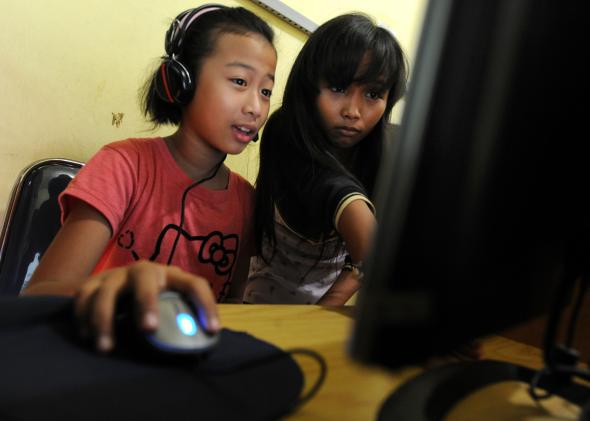Fellow parents, I’ll bet this sounds familiar: We face a gazillion apps and games claiming to be good for our kids. Yet we are peppered with headlines about why screen-based technology may be bad for them. What we need is a trusted guide. Where is our Dr. Spock of digital?
Without help, we are vulnerable to garbled translation when the science of media and child development is translated into headlines. In the latest issue of the Journal of Children and Media, I put a spotlight on this vulnerability and decided to let it all hang out by describing a moment during my tenure as a technology reporter a decade ago. I reflect, embarrassed, on my shallow understanding of research before writing my book Screen Time. For example, baby videos like Baby Einstein and Brainy Baby were being labeled as “research-based,” when as it turns out, “research-based” can mean almost anything. Just like parents, reporters are desperate for guides.
For many years, only one national organization has tried to fill the role: the American Academy of Pediatrics, the organization that holds the mantle for guidance on health issues like breastfeeding and food allergies. In the late 1990s, the AAP was among the first medical organizations to recognize how much music videos, the Internet, and video games had become part of childhood and it started warning of health risks and promoting media education campaigns. Its Council on Communications and Media has produced more than a dozen policy statements. For many parents trying to raise healthy kids, and for reporters looking for stories, the AAP becomes the final word.
The problem is, in the realm of digital media and technology, the world is changing faster than scientists can investigate it. Which means that some AAP recommendations rely on less-than-solid research—or, in the case of a 2011 report that introduced the term “Facebook Depression,” no science at all.
The AAP’s 2011 report said: “Researchers have proposed a new phenomenon called ‘Facebook depression,’ defined as depression that develops when preteens and teens spent a great deal of time on social media sites, such as Facebook, and then begin to exhibit classic symptoms of depression.” Time, the Boston Globe, New York’s NBC station, and international newspapers picked up the story, and many put “Facebook Depression” in their headlines. The co-author of the AAP report, Gwenn O’Keeffe, created a website called Pediatrics Now to promote herself as a trusted source on healthy digital behaviors.
Yet within a few days of the report’s release, CNET reporter Larry Magid had published an article and audio interviews casting doubts on the AAP’s claims, relying in part on a critique by psychologist John Grohol, founder of PsychCentral. Only two of the citations referred to peer-reviewed journals and not one referred to research showing that social media use caused depression. One of the researchers cited, Joanne Davila of the State University of New York at Stony Brook, says her study was misinterpreted in the AAP’s report and has created a webpage with a detailed explanation of what went wrong in the way her study was reported.
The AAP Facebook depression episode is becoming a cautionary tale of how not to talk about media and its impact. In a new book called Sex, Drugs ‘n Facebook, pediatrician Megan A. Moreno is intent on undoing the damage. In a section of the book titled “Facebook Depression: Media Hype, Not Medical Illness,” she writes: “While we argue for a healthy balance between online and offline time for many reasons, including promoting good mental health, it appears that warning parents about ‘Facebook depression’ may have been premature.”
Instead, Moreno’s book provides tips and “conversation starters” for parents who have seen their teenagers express negative thoughts about themselves on Facebook: Don’t be judgmental. Start with questions. Reach out. Teens in surveys have shown that they want their parents to come talk to them face to face.
I’ll bet that guides like Moreno’s—that resist the temptation to turn legitimate questions into overstated answers—are going to become more and more useful to parents. Another good resource is Common Sense Media, a website I turn to weekly for its well-reasoned articles and crowd-sourced advice from “experts” as well as parents. Other places to look include the reviews and smart thinking from Children’s Technology Review and Parent’s Choice.
None of these sources, however, are designed to continuously filter and translate the growing pile of science and in-depth research on media and children’s healthy development, not to mention whether the use of different technologies helps meet their needs for intellectual growth and creative outlets for expression.
That is why the AAP’s role has become so important, and why I do take some comfort in more recent statements from the AAP about younger children and the need for family “media plans.” Those statements are starting to reflect the latest research that examines healthy use within different contexts and types of content (paying attention to what actually shows up on the screen), instead of only worrying about time spent. Also heartening is a new cohort of organizations, including the research and policy group known as the Ounce of Prevention Fund, that are focusing on early learning and young children’s relationships with digital media. (They helped to seed a wide-ranging research discussion we hosted at the New America Foundation in Washington, D.C., last October.)
Now we need other health and education organizations to take on the task, too. Reporters and national organizations that have the ear of parents have a responsibility to help with this issue—and then get it right. No parent likes to discover that the experts are just as lost as we are.
Also in Future Tense: Emily Bazelon talks to writer Danah Boyd about her new book It’s Complicated: The Social Lives of Networked Teens.
